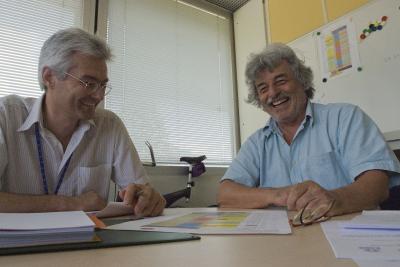- Home
- News
- General News
- In sync: 100 days...
In sync: 100 days of the new directors of research
04-09-2009
In the new issue of ESRFnews, Harald Reichert and Serge Pérez, the new directors of research, discuss the challenges of the Upgrade programme, their day-to-day work and how they lead the science of the ESRF.
Share
The following is an extract of the complete interview (page 15).
How was your first encounter?
Serge Pérez (SP): We met for the first time when we signed the contract.
Harald Reichert (HR): It was unceremonious, it took place in one of the small seminar rooms in the central building of the ESRF.
SP: When we were appointed to the job separately, no-one told us who was going to be our “partner”. In a way, it is like being married to someone you don’t know, like an arranged marriage…
HR: …which is not unusual for scientists, because you are used to starting a new job every now and then and having to integrate yourself in a new environment.
SP: As scientists, we share the same ethical and working models, so that makes our relationship very easy.
Tell us about the first 100 days.
SP: The Upgrade is really a driving force. We are also working on the definition of partnerships. At the moment we have the Partnership for Structural Biology and we use it as a model, but we need to define new partnerships, such as for soft condensed matter, extreme conditions, paleontology and maybe on magnetism in phase 2 of the Upgrade.
HR: Since our arrival, most of our tasks have been linked to the Upgrade programme. We have already worked heavily to prepare the autumn meetings (Science Advisory Committee, appoint beamline allocation panel). One of our major duties is the space audit, which is a big thing. It consists of assessing whether we need extra room during the construction work within the Upgrade and should spend money on this or whether we are better off sharing office and lab space temporarily while the works are under way and invest the money in science.
 |
|
Harald Reichert (left) and Serge Pérez (right) during the interview. |
What has been the biggest challenge?
HR and SP: The Upgrade.
HR: We have to run the division and at the same time make many decisions for the Upgrade.
SP: At some point we will also face a change of culture at the ESRF, in our division.
HR: With the Upgrade, we have a plan for seven years, a frame on how to spend the budget that has already been allocated. This is why we asked scientists to come up with the 31 conceptual design reports (CDRs) for the entire portfolio of public beamlines at the ESRF. All of this means that if someone has a new idea that is not covered by the CDRs during the next seven years, we may pursue it, but we will have to cancel something else. We can’t do everything that we plan to do in the next seven years plus any new ideas that come up along the way.
SP: So we need to help scientists to find financial resources from other external sources.
HR: Another crucial aspect is that we should not just add new techniques to the beamlines.
At some point we have to redefine the mission of beamlines and give them an orientation to new directions. This is difficult for scientists.
SP: We are going to be facing this situation soon.
HR: In fact, we have already taken decisions in that direction. No beamline will be closed, but it can change its mission, and this need for change normally happens very naturally. The strength of the ESRF is the highly specialised and unique beamlines and we should keep it like this.
SP: We also want to avoid duplication with national light sources, which push us to have very specialised stations that they can’t offer.
HR: We do as much as we can to supply the best conditions for users and, despite the new synchrotrons, the user community is not leaving us, which is a good sign.
Top image: The directors of research at work.



